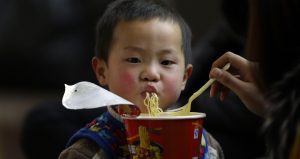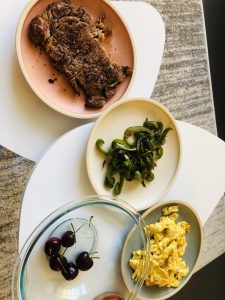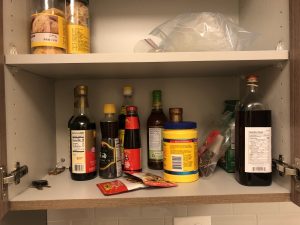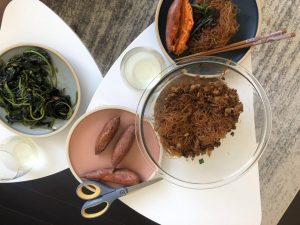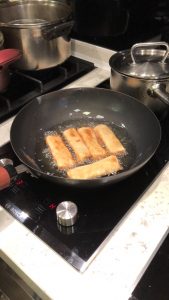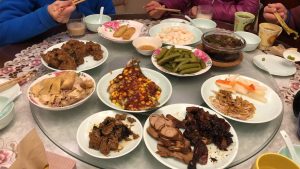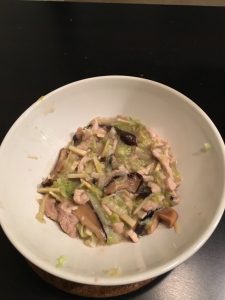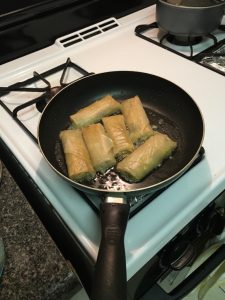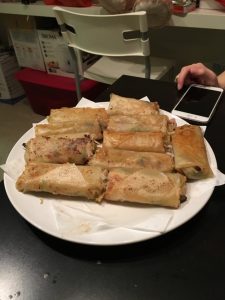When you travel to Japan or visit a Japanese restaurant, you may know or actually taste a bowl of Japanese Ramen. It is a very popular noodle dish among the world now. You may find several authentic Japanese Ramen chain restaurants all over the world. You even could say it is one of the symbols of Japanese culture. “Kodawari” is a unique and special word in Japanese that you hardly can find a synonym for it in English. It means “the uncompromising and relentless pursuit of perfection”. (Hagan, 2017) This custom is in every Japanese traditional craftmanship. It is also very important feature in the Japanese Ramen’s craftmanship. Japanese Ramen is different from Chinese Ramen; however, it is served in Chinese cuisine restaurants in Japan. It is considered a Chinese originated dish. As this noodle dish become more and more popular among Japanese people, more and more Japanese-Ramen-only noodle shops were opening up. In addition, Japanese people has their own “Kodawari” on this dish, which they adapted from Chinese but created their own flavors and culture. It is very interesting to find out how Japanese ramen evolve from the originated Chinese Ramen and its unique characteristics; how Japanese people value the Japanese Ramen.
According to the article “Japan’s Ramen Romance”, noodle dishes in Japan were adapted from China about 1500 to 2000 years ago. After several centuries’ transformations and evolvements, there were over 60000 Chinese restaurants where ramen is an indispensable item on the menu. This number is way beyond 30000 establishments that serve traditional Japanese soba (buckwheat noodles) and udon (thick noodles made of wheat flour) back in 1999 (Ayao, 2001). The ramen became popular because of a sudden change of climate in 1945. Japan has a rice-based culture. However, Japan recorded its worst rice harvest in 42 years and lost the war colonies in China and Taiwan in 1945. The bowl of wheat noodles gained prominence. (Lu, 2018). So, what is Japanese Ramen? Literally from dictionary, “Japanese noodles of wheat flour, usually served in broth with pieces of vegetables and meat” (Collins Dictionary). It is different from soba and udon as it is in yellow color. The noodles are usually made of flour, water salt and a special type of mineral water (kansui). (“Basics of Japanese Ramen, Its History and Types”). Different from Chinese Ramen, the noodle is not limited to “pulled noodles”. When you are in China, ramen noodle restaurant is usually about “hand pulled noodles”, such as Lanzhou Ramen. However, Japanese Ramen noodles can be prepared in advance and made by machine. The soup base is mainly made from chicken, pork and fish stock. Usually, the soup is made of shiitake mushrooms, katsuobushi (skipjack tuna flakes), kombu (kelp), niboshi (dried baby sardines), beef bones, and onions. (“Basics of Japanese Ramen, Its History and Types”). The toppings of the traditional Japanese Ramen include sliced pork (叉焼 chāshū), nori (dried seaweed), menma (a kind of bamboo shoots), and scallions. There are many variations of Japanese ramen nowadays, but the main kinds can be divided by soup variations: shoyu (soy sauce), Tonkotsu (pork bone), miso ramen (fermented soybean paste flavored), shio ramen (salt ramen) and Tsuke-men (dried noodle). The toppings usually are the same for each flavor, but nowadays, more and more Japanese Ramen has its own toppings. Different regions have their own characteristics of Ramen. For example, Sapporo Miso Ramen, Hakata Tonkotsu Ramen, Kitakata Ramen, Wakayama Ramen, Onomichi Ramen and many other famous regional Ramen (Gurunavi, 2018). Different regional culture backgrounds add the variety and uniqueness of Japanese Ramen.
When trace-back the history of Japanese Ramen, you will recognize that it is a story of immigrants’ “Kodawari”. Back in 1840s, China lost the war and forced to open up the Guangzhou and Shanghai’s port to Britain. Japan finally changed from near-isolation in 1854, due to the Japan-U.S. Treaty of Peace and Amity, and also the Treaty of Amity and Commerce of 1858. Mostly, the cities along the sea side are the first ones that did businesses and trading. Many Chinese people came to Japan and employed by these trading houses (Ayao, 2001). China was also defeated in the Sino-Japanese War (1894-1895), therefore, many Chinese students came to Japan. In order serve these people, immigrants from China created Shina soba and Nankin soba in these harbor cities in Japan. The author of the “Japan’s Ramen Romance” stated that “Foreign culinary cultures are often introduced by immigrants who have left home for any number of reasons- war, political instability, poverty and so on….Ethnic foods influence traditional local cuisine and vice versa, bringing forth new hybrid dishes”. Therefore, the mix of culture created the term of Japanese Ramen. Wang Wencai, a Chinese chef who fled Russian Revolution and went to Sapporo in Hokkaido in early 1920, was the one that credited for first use the term “Ramen” in this dish. As this dish was so popular and attracted many people, Wang eventually had to drop the time-consuming, hand-pulled method. He was doing the traditional Chinese Ramen – the hand-pulled noodles, at first. But after the restaurant bought a noodle-making machine for less time making noodles, it created the difference and uniqueness of Japanese Ramen (Ayao, 2011). You could say the first Japanese Ramen was created in Sapporo. Sapporo has this rich historic background, and the influences were still there. Sapporo is known for its “Sapporo Ramen”. Many other Ramen shops all over the world ordered noodles from noodle making small factories in Sapporo, for their “Kodawari” on noodle-making machines and their noodle-making techniques.
America’s influence had a huge impact on Japanese Ramen. After the creation of the first Japanese Ramen, it was a period of time that Japan had a severe food shortage. It was also the period of time that Japan was defeated in the war and occupied by United States. In order to solve the issues on food shortage, Americans started to import massive amounts of wheat. This history created a culture- making Ramen noodles and eating at a black-market stall (Lu, 2018). According to the author of “The Illegal Ramen Vendors of Postwar Tokyo”, “Black markets had existed in Japan throughout the war. However, they became increasingly essential during the last years of the war and throughout this period of occupation. With the government food distribution system running about 20 days behind schedule, many people depended on black markets for survival. The black-market stalls are called “Ameyokocho” and located underneath an active train line and announced their presence with the distinctive sound of “charumera” flutes and sold ramen from a “yatai” (Lu, 2018).The “yatai” menas a moving cabinet, containing a stove to boil the soup and water, and with wheels. Americans were regulating the outdoor food vending as the wartime ban, huge amount of flour for ramen was secretly diverted from flour milling countries. The black markets were under the control of the “yakuza”, Japanese local mafia. The “yakuza” extorted the vendors for protection money (Lu, 2018). After the regulation loosened up, more and more Japanese Ramen stall appeared. Back then, Japanese cuisine did not have a dish that contained rich fat and strong flavors. Japanese people then recognized that the Ramen is a stamina food. Many people had a feeling of “being stronger” after eating a bowl of Japanese Ramen. It was not surprising that Americans aggressively advertised the “nutritional superiority of wheat and animal protein, endowing ramen with a nutritious reputation and a welcome change for a population weary of rationing”. (Lu, 2018). As the economy had not recovered, the Japanese Ramen stalls’ business model was the few that still work for ordinary people to start up a small business entrepreneurship. In addition, ramen became a symbol of urbanization. As more and more people worked in the city and came out late in the night, many employees huddled the “yatai” in a bombed-out city. A Japanese Ramen “yatai” is casual, relaxed and cheap. It is also comfy and full of stamina and energy for an after-work stomach.
As the ramen became more and more popular, it was a blooming food industry. More and more varieties and creative flavors of Ramen had been developed. Each chef has their own understanding of Ramen, and each one has his or her own “Kodawari”. However, traditional Japanese Ramen chefs does not pay much efforts on their “Kodawari” on changes or creativities; they are more focused on the depth on each aspects of original Japanese Ramen. First of all, is the “Mein”, the ramen noodle. You may find many advertisements saying “The noodles are made by own” (自家製麺). The chef’s “Kodawari” is on the “resistance to the teeth” in Japanese ( 歯答え). You may say it depends on how long you boil the noodles in the hot water. To the Ramen expert, the ingredients of the ramen noodles and the balance of flour, water and even the salt play very important role to the “resistance to the teeth”. Many Ramen chefs will order noodles from far away to have the perfect kind of ramen noodles. They have the “Kodawari” on the ingredient origins. Kagawa province, Fukuoka province and etc. are the provinces that famous of providing the flour for Ramen makers. There are few noodle factories that were famous for their craftsmanship that located right in these provinces. They have their own “Kodawari” on the flour, or even the water. I have heard about that they select a kind of spring water to make the noodle, which is in the mountains and hard to fetch. I have heard about a special case for the “noodle shape”. Usually the noodles transverse section is a square or a rectangle. However, some chefs’ “Kodawari” demands the transverse section to change shapes. This is for better balance on how the noodle absorbs the broth and affects the resistances when you are chewing. You may notice a saying, “the soup is the soul of a bowl of Ramen”. There three main kinds of soup base in Japanese Ramen, chicken broth, pork bone broth and fish broth. Each kind has its variation, but all cost a lot of time to make the soup base rich. It also cost years to develop your own secret receipt for a balanced soup base. I have watched several Japanese TV shows regarding the Ramen soup. Some of them use rare and expensive ingredients and cook by days to only use its broth. Fish is tuna or salmon, pork bones are black hogs’ bones, and endless other spices, secret ingredients. Toppings are also made by each Ramen shop itself. Chefs can have creative “Kodawari” on the toppings: the balance between the fat and lean on sliced pork (叉焼 chāshū) and what other kinds of the vegetables can fit with the soup and noodles. After all the efforts on the ingredients and flavors, the technique on cooking ramen is also a key point. A huge amount of Japanese Ramen restaurants has open restaurant and you may watch how the chef cook the Ramen. I believe you will be surprised or amazed how they do “draining the hot water from the noodle” (湯切り). Sometimes, the chef will directly swing the noodle in a drainer net and drain hot water on the floor. It is a technique as it is hard to not get burn from the boiling water. The experts on Ramen has the “Kodawari” on how the noodles cool down and dry up during this technique. There is another technique of cooking the soup. You may see these huge wooden stirring sticks used by the chef to stir the soup. The direction of stirring and how often to stir and soup is also a key “Kodawari” that a Ramen chef care about.
“Kodawari” needs time, patience and efforts. As for the owner of Kunimoto Mengokoro, the Kunimoto chef starts working from 8 am to 11:30 pm, six days a week. For him, it is not about creativeness of a new type of Ramen, but how to make traditional Japanese Ramen to the perfection. After the restaurant is closed, Chef Kunimoto still needs to cook and prepare all the ingredients and clean the kitchen. For him, the Japanese Ramen is all he has. He devotes everything he has to this ramen. He said that, “As it varies people to people for judging whether my Ramen is delicious or not, for me, I must dedicate myself in to this Ramen bowl (“What Owning a Ramen Restaurant in Japan is Like”, 2016). All his “Kodawari” is in this bowl of Japanese Ramen.
Works Cited
Ayao, O. (2001). Japan’s ramen romance. Japan Quarterly, 48(3), 66-76. Retrieved from https://login.proxy.library.emory.edu/login?url=https://search-proquest-com.proxy.library.emory.edu/docview/234912694?accountid=10747
Basics of Japanese Ramen, Its History and Types. Retrieved from https://hubjapan.io/articles/japanese-food-ramen-history-and-types
Gurunavi. (2018, February 26). 11 Types of Japanese Regional Ramen for the Epicurious Traveler. Retrieved from https://gurunavi.com/en/japanfoodie/2018/02/regional-ramen.html?__ngt__=TT0fbc8b4ae006ac1e4aee4aXLU5W-KThzrwD-k81rUtK9
Hagan, C. (2017, June 26). Kodawari. Retrieved from https://medium.com/mistletoe-intern-life/kodawari-31cc4692c922
Lu, H. (2018, August 24). The Illegal Ramen Vendors of Postwar Tokyo. Retrieved from https://www.atlasobscura.com/articles/how-did-ramen-become-popular

